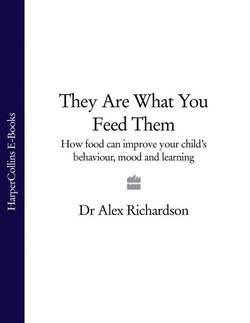Читать книгу They Are What You Feed Them: How Food Can Improve Your Child’s Behaviour, Mood and Learning - Dr Richardson Alex - Страница 89
Magnesium
ОглавлениеMagnesium carries out hundreds of biological functions for you, and is absolutely essential for good health. It helps keep your bones and teeth strong, and your heart rhythms steady. It also helps you to make proteins, is important in energy metabolism (including blood-sugar control) and helps regulate muscle and nerve function, immune reactions and control of blood pressure.
If your ADHD or ADD child suffers from light or restless sleep and daytime sleepiness, try adding calcium and magnesium-rich foods to his diet. These include: milk products, cocoa, sardines, green leafy vegetables, tofu, brown rice, whole grains and beans.
See also: 10 Effective Ways to Help Your ADD/ADHD Child by Laura Stevens, and her excellent website with dietary tips at http://www.nlci.com/nutrition/.
Magnesium powerfully affects ‘nervous excitability’, and deficiency states are characterized by tension, agitation and stress. Lack of magnesium is linked with many psychiatric conditions, including anxiety and panic disorders, Tourette’s syndrome (involving involuntary movements or speech utterances known as ‘tics’), autism and ADHD.31 There’s preliminary evidence of benefits from magnesium supplementation in ADHD children, although this still needs confirming in rigorous randomized controlled trials.32 Early signs of magnesium deficiency include loss of appetite, fatigue, weakness, nausea or vomiting, muscle contractions and cramps, numbness and tingling. Severe deficiencies can lead to seizures, personality changes and heart rhythm abnormalities.
Unfortunately, magnesium deficiency in the diets of UK children is even more common than lack of calcium. As the national surveys show, average daily intakes of magnesium fall short of ‘reference nutrient intake’ levels in all except those under 6 years of age. In boys aged between 11 and 18 years, one in every four or five has a frankly deficient intake of magnesium; for girls of the same age, it is more than half of them.33
All green vegetables provide magnesium (it’s in the chlorophyll that gives plants their green colour), as do most nuts, seeds and grains. A wide range of different foods containing magnesium is needed, though, as no one food is a particularly rich source. Along with a lack of fruit and vegetables, this is where many children (and adults) go wrong, of course—but I hope you can see once again why it’s so important that you encourage your child to eat a wide variety of whole, fresh, unprocessed foods.
